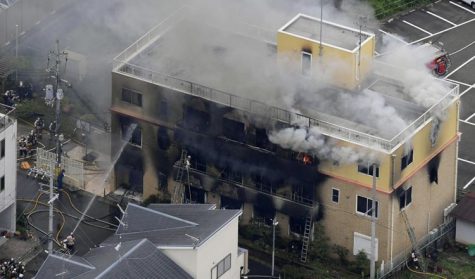#PrayForKyoAni: Arson Murder Case of Kyoto Animation
October 9, 2019
On July 18th, 2019, one of the deadliest massacres in Japan’s history since the end of World War II and the deadliest building fire in the country in almost 20 years occurred in Fushimi-Ku, Kyoto, Japan.
Around 10:30 a.m., a middle-aged suspect broke into Studio 1, the main animation studio of Kyoto Animation, and poured about 10 to 15 liters (about 3 to 4 U.S. liquid gallons) of gasoline on the first floor and onto several employees, before igniting them with a lighter. Thereby, a fire and an explosion occurred.
The fire lasted for approximately 20 hours. Out of 70 employees who were at the studio at that time, 35 were killed, 36 were severely injured, and, along with the studio, numerous past drawings and archived documents were destroyed.
The structure of the building also seems to have amplified the damage. The Kyoto Fushimi police stated that many of the victims’ deaths were due to carbon monoxide poisoning, which suggests that they had their escape routes cut off by the fire and died unable to break out of the building. Many of the victims were so severely burned that no one could identify them afterwards.
The Kyoto Animation arson incident shocked “Kyo-Ani” fans all over the world and generated a voice to commemorate the quality of Kyo-Ani’s work. Most of the commemorations and worries are for the deceased animators and their families. However, some anime fans have lamented the artistic losses.
Kyoto Animation, founded in 1981, produced popular anime works such as “K-ON!” And “The Melancholy of Haruhi Suzumiya.” Since its inception, Kyoto Animation has produced stunningly delicate and precise art that reflects the complex psychology of adolescence–so much so that the style is known as “Kyo-ani Quality.” With the hashtag “#PrayForKyoAni,” social media has been filled with fans’ condolences and support. Many fans cite their favorite works and recount how Kyo Ani’s creations have influenced them over the years.
Even now, about two months after the arson, the voices of praying for the well-being of the victims both inside and outside of Japan are constant. It reminds us of how the works of Kyoto Animation that represent Japanese animation, or “Japanimation,” are loved all over the world.
The circle of support for Kyo-Ani is also spreading. “Sentai Film Works,” an American anime distribution company that distributes Japanese anime works such as Kyo-Ani overseas, ran a crowdfunding campaign this past summer to support the studio. About 69,000 people pitched in, and total donations reached about $2.37 million.
Yet despite the amount of support, Kyoto Animation, an SME (small to medium-sized enterprise) supported by craftsmanship at home, is facing a crisis of business suspension. The valuable talent and ability we have lost in the arson can never be restored.
For now, the most we can do is pray for the survivors’ safety and the recovery of Kyo-Ani.

